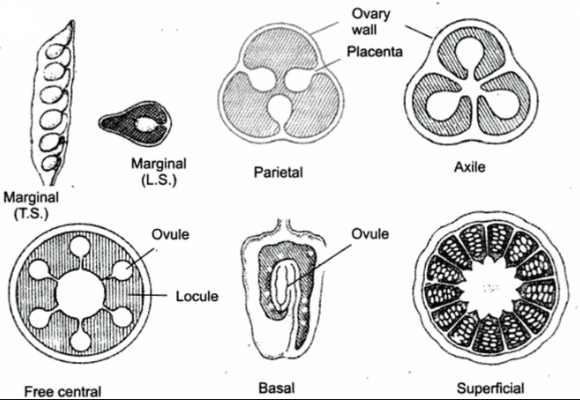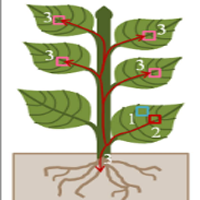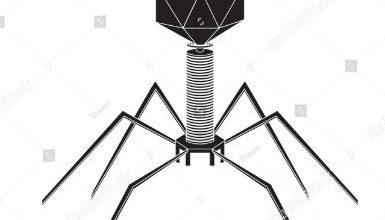Placentation
the manner in which the Plantae are distributed in the ovary is called Placentation and it is helpful in classification.
Types of Placentation
in a simple ovary (Formed of one carpel) there is only one type of placentation.
- Marginal: the ovary is single-chambered and the ovules are attached to the Plantae that develop along the ventral suture i.e., along the fused margins of the carpel. i.e., ventral suture, as in pea, Gram, Bean, Cassia.
In compound ovaries, the placentation may be parietal, axile, free central, basal, or superficial.
- Parietal: the ovary is compound and unilocular. the margins of the carpels swell up to form Plantae as is found in cucumber, melon, Brassica, etc.
- Axile: the gynoecium is polycarpellary and syncarpous. the fused margins of the carpels run inwards and meet in the center of the ovary. the ovary becomes multilocular, and the marginal Plantae of all the carpels fused in the center to form a central or axile column to which the ovules are attached. the number of loculi indicates the number of carpels e.g. potato (2 loculi) Euphorbia (6 Loculi).
- Free central: the ovary is compound and unilocular. the ovules are borne on a central axis arising from the base of the ovary and not on the fused margins of the carpels as in dianthus, Primrose (Primulaceae).
- Basal: the ovary is unilocular and the Plantae develops directly on the thalamus and the single ovule is attached to the Plantae at the base of the ovary as in sunflower.
- Superficial: the ovules are present all over the inner surface of the ovary which may be syncarpous as in water lily, or apocarpous as in the flowering rush.
Vertical Section
vertical section of flower refers to its having been cut vertically in a median plane. it furnishes the following information.
- It depicts the shape and relative size of the floral parts.
- it provides an idea about the insertion of floral parts on the thalamus.
- it provides information about the fixation of anthers, the position of nectaries, and placentation in the verticle plane.
Floral Formula
A floral formula is a short symbolic representation of the various features of a flower. it furnishes information about:
- the symmetry of the flower e.g, whether the flower is actinomorphic or zygomorphic.
- the sexuality of the flower i.e, whether the flower is bisexual or unisexual.
- about the number and state of floral parts e.g., free or united.
- regarding the inferior and superior nature of the ovary.
- about the presence of epicalyx and epipetalous nature of stamens.
the various symbols used in floral formulas are as under:-
- Sex of the flower
- Bisexual
- Unisexual (Male)
- Unisexual (female)
2. Symmetry of flower
- Actinomorphic
- zygomorphic
3. number and conditions for sepals
Calyx
Epicalyx, if present, is represented by the Letter “Epi K” and is mentioned before K. The fused nature of floral parts is shown by enclosing the numbers in the breast, e.g. K(5) indicates a calyx comprising five fused sepals.
If sepals, petals, and stamens are present in two whorls, then the number of constituent parts in the outer whorl is mentioned first, and then the sign of plus (+) is put before mentioning the number of constituent parts comprising the second whorl.
For example, suppose a calyx consists of four sepals, of which two are present in the inner whorl and two in the inner whorl then„ in the floral formula, such a condition is represented as K2 +2.
The superior nature of the ovary is indicated by putting a small straight line below the number of carpels; e.g., G(3) The inferior nature of the ovary is indicated by putting a small straight line above the number of carpels, e.g., (G3).
In Brassica:
- Flower: Actinomorphic, bisexual.
- Calyx: 4, free, in two whorls of two each.
- Corolla: 4, free.
- Androecium: Polyandrous, Tetradynamous.
- Gynoecium: Bicarpellary, syncarpous, superior ovary.
The floral formula of such a flower will be as follows:-
Floral Diagram
A ground plan showing the relation of floral leaves to each other and to the axis is called a Floral Diagram. It explains the number and positional Arrangement of the floral leaves in one view. The axis on which the flower is borne is known as the Mother Axis. The side of the flower towards the mother axis is Posterior, and that towards the bract or away from the mother axis, Anterior.
A line is drawn across the flower, passing through the mother axis and the Centre of the flower indicates the Antero-Posterior or Median Plane. A line at right angles to this, also passing through the center of the flower, indicates the Lateral Plane.
The planes which bisect the angles formed by the median and lateral planes are called Diagonal Planes, while all other planes are said to be oblique. The mother axis is indicated by a dot or a small circle in the
anteroposterior plane above the diagram. No dot is shown in the case of a terminal flower.
The sepal or petal lying just opposite the mother- axis is the odd Sepal or Odd Petal. The floral leaves usually alternate with one another. If a sepal is odd, the mother will be lying between the two petals.
Beginning with the odd sepal, or odd petal, the exact number of sepals and petals are represented by brackets which are broader in the middle and taper towards the end. The sepals are shown in the outer circle and the petals are in the inner. Gamosepalous and gamopetalous condition is shown by linking the ends of the brackets.
The stamens are indicated by small kidney-shaped ‘figures, if the androecium is epipetalous, the stamen figures are linked by radial lines to the petal brackets.
If the stamens are united, the stamen figures are connected with each other by an arc or circle. If there are two or more alternating whorls of stamens, their number and position are indicated accordingly. The gynoecium is shown in the Centre of the diagram in the transverse section.
The ovary is drawn in a double line and the number of carpels is indicated by as many constrictions. The septa are shown by radial lines meeting in the Centre and the ovules are represented by small rounded figures attached to the placentas.
Homologies | |
| Carpel | Megasporophyll |
| Ovule | Mega sporangium |
| Embryo Sac | Female Gametophyte |
| Egg | Female Gamete |
| Stamen | Microsporophyll |
| Anther | Microsporangium |
| Pollen grain | Microspore |
| Germinating Pollen grain | Male gametophyte |
| Ovule | Seed |
| Funicle | Stalk |
| Integuments | seed coat |
| Hilum, raphe | Hilum, raphe |
| Chalaza & Micropyle | Chalaza & Micropyle |
| Nucellus | Perisperm |
| Embryo Sac | Embryo |
| Egg cell | Endosperm |
| Endosperm nucleus | Disintegate |
| Synergids | Disintegrate |
| Antipodal cells | |
Flower a Modified Shoot (Placentation)
The following facts may be cited to prove that the Thalamus is a modified branch; Sepals, Petals, Stamens, and Carpels are modified vegetative leaves; and the Flower as a whole is a modified leaf-bud. Placentation
- The floral axis, or the thalamus, is normally exceedingly short. But in some Flowers, as in (Capparis), etc., the thalamus becomes elongated and then, like the branch, it shows distinct nodes and internodes.
- Rose, Larkspur also, sometimes shows monstrous development of the thalamus, i.e. after bearing the floral members, the thalamus prolongs upwards and ordinary foliage leaves. Sometimes in Pear also the thalamus elongates, passes through the flower, and ultimately bears green leaves. The thalamus thus behaves as a branch.
- The leaf-bud is normally axillary or terminal in position; the flower-bud likewise occupies the same position. The leaf bud thus becomes modified into the flower bud when the flowering season conies.
- The arrangement of sepals, petals, etc., on the thalamus, is the same as the leaves on the stem or the branch, in other words, the floral phyllotaxy follows the law of the phyllotaxy of foliage leaves. Although most flowers show a whorled phyllotaxy, an alternate arrangement is met within the flowers of water Lily, Cactus, etc.
- Sepals, petals, etc., always arise from the nodes of the thalamus, just as the leaves do from the nodes of the stem or the branch, and they remain rolled or folded in the same way in the flower-bud as the vegetative leaves in the leaf-bud. Even their arrangement with respect to each other (aestivation) is the same as that of the foliage leaves (prefoliation). Moreover, like the young leaves of the leaf-bud, the floral leaves of the flower-bud open in strict acropetally succession.
- The foliar nature of the floral members may be made out of the fact that they show peculiar Modifications with transitional stages in many cases. Sepals are mostly green in color and look like leaves. In fact in Mussaenda, one of the sepals becomes a distinct white or colored leaf. Petals, although colored, have also some resemblance to leaves. -In fact in green roses and in some cases Larkspur petals are green in color. But stamens and carpels are unlike leaves in all respects. Their homology with leaves can be made out of certain flowers. Thus, Water Lily shows a gradual transition from sepals to petals, and from petals to stamens. The cultivated Rose shows many petals; while in Wild Rose there are only five. The explanation is that many stamens have gradually become modified into petals in cultivated roses. In certain varieties of ‘Jaba or China Rose and Hibiscus mutabilis, some or many of the stamens have passed into petals. In some Roses, carpels are seen to be replaced by green leaves. In Canna, the stamens and the style have become petaloid. In some garden plants, e.g., in clitoria, Cape Jasmine, etc., a ‘doubling’ of flowers is often met with. This may be due to the modification of some of the stamens into petals. Now and then it is seen among the season flowers, as sometimes in Zinnia, that some of the stamens and carpels become modified into distinct petals. Placentation
- The inflorescence axis normally bears flowers. Sometimes, as in Aloe (Agave), some of the flower buds become modified into leaf buds, called Bulbils, vegetative reproduction. In Gaillardia, now and then some of the flowers of the inflorescence become modified into leafy branches.
In Pineapple, the inflorescence axis ends in one or more buds (bulbils) for vegetative propagation of the plant. These organs thus show a reversion of ancestral forms, i.e. the forms from which they had been derived. Placentation
You May Also Like:



